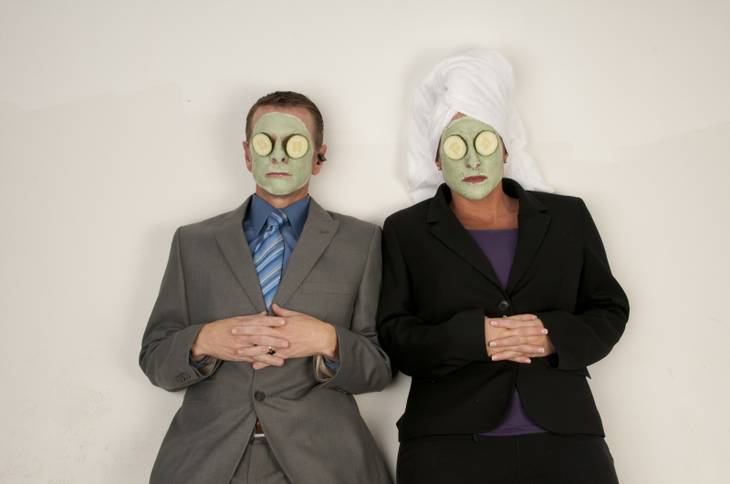The elements of style
At first blush, Kat Toussaint is, above all else, a hair stylist, among the legion of workers — most of them women — toiling in the business of beauty in Las Vegas. She is one of about 275 hair stylists, nail technicians, beauticians, facial experts and others who rent space at Body Spa West, a 20,000-square-foot beauty emporium on West Charleston Boulevard. The owner says it’s the largest salon on the West Coast.
Toussaint, a Las Vegas native, pays $250 a week to work in a room of eight hair experts. Her station is next to the front window, for which she’s paying a $10 premium.
She’s certainly good at what she does, and wholly enjoys it. She began styling hair in college when she majored in photography and helped prepare her subjects’ hair for shoots. When she took a job running the ticketing and entertainment departments at Monte Carlo and Luxor, she found herself missing her chair. So 10 years ago, she returned to hair styling.
But her real skill may have nothing to do with her scissors and blow dryer. Listen to her talk about the beauty business, and you wonder why she isn’t leading a 300-level practicum in how to survive the recession in a business that relies on discretionary spending.
“When Yucca Mountain shut down and all the Bechtel people left, I lost 25 clients, plus some of their spouses. So make it 35,” she said. “When the housing bubble burst? There went my clients in real estate, the mortgage business, interior designers, construction people. At one point I had 200 clients, and then I lost a third of them. My income is down a good $10,000 a year. That’s serious money, because I’ve still got my own mortgage to pay.”
Toussaint isn’t just griping. She’s doing something about it. Because she’s not just a hair stylist, she’s an entrepreneur trying to save her business. And when you listen to her action plan, you realize it probably contains good advice for other business owners — even if they spend more time in a saloon than a salon.
“I’m marketing on Facebook. I’m keeping up with education and the latest cuts so my clients know I’m not doing a cut from the 1980s,” she said. “I’m donating services at charity events and fundraisers just to get my name out there. And three colleagues and I are doing house parties where we show the hostess and her friends how they can style their hair at home before going out for the night, and what products to use.”
Isn’t that cutting into their business? Well, maybe, but the goodwill goes far, she says. “And we don’t show them how to color their hair. That’s what we do.”
Oh, and those hair products? So happens that Toussaint and her colleagues sell them, because they’re also in the retail business.
“It’s all about being creative,” Toussaint said. “You throw darts and see what sticks.”
Her most successful effort in growing her business is in getting referrals. She gives a coupon for 20 percent off to clients for every new customer they send her, then gives those new customers 20 percent discounts on their first visits. “I’ve had clients ask me if I can adjust my prices because times are tough. I tell them, ‘Sure, bring me customers and I’ll adjust my price for you.’ ”
The other requisite in getting referrals? The most basic advice of all: “You’ve got to provide good service to the clients you already have.”
• • •
About 16,000 men and women are employed in the cosmetology, hair, nail or skin-care business in Southern Nevada, according to the Nevada Board of Cosmetology. They work in a region where vanity is pervasive; Las Vegas ranks with New York City and Los Angeles’ West Side for its obsession on beauty, industry insiders say. Tourists come here to be pampered at our spas and salons, and locals have their own reasons to look beautiful, depending on their jobs and quest for tips.
Don’t underestimate the business acumen of some of these beauty workers for a moment — especially when considering they were trained in beauty, not business. The successful ones speak the language of entrepreneurs, their conversations sprinkled with references to startup costs, price points, locations, capital investments, marketing, community goodwill, continuing education, flexibility and, most important, customer satisfaction. And the stylists and others who aren’t smart businesspeople? Hair today, gone tomorrow.
For some beauty dispensers, it’s still a cottage industry. That group includes freelancer Barbra Jo Batterman, for 36 years a makeup and hair stylist, who will spring into action at 1 a.m. if a concierge calls because a resort guest wants a late-night bikini wax, or there’s a video production company in town and there’s a call for 18 stylists to beautify performers for a shoot. (Batterman credits high-definition video for her upsurge in male clients: When they give convention speeches and their faces are displayed on enormous video screens, they begin to pay more attention to ear and nose hair.) Batterman grouses that Las Vegas is saturated with stylists and that she’s had to reduce her prices by about 25 percent in order to compete. “People are selling themselves short” in order to land work, she says of the competition.
Other industry workers own salons, such as Barb Garcia-Grove and Rick Grove, who have owned Square Colour Salon + Spa for five years. The two talk about their various efforts to give back to the community, including giving discounts for teachers.
“The recession has touched everyone one way or another,” Garcia-Grove said. “We’ve been blessed to be successful.”
In the big picture, the beauty industry is doing well despite the recession. The NPD Group, an international marketing research company, estimated that in 2010, people spent $43.5 billion in the United States to get beautiful. Various trade groups reported that the industry never flatlined during the recession and that growth has picked up to the rate of 3 to 4 percent annually. Vincent Jimno, executive director of the Nevada Board of Cosmetology, said that despite the recession, the ranks of beauty professionals grew between 1 percent and 2 percent between 2007 and 2010, and had grown at a faster clip since.
Here is a decidedly different but telltale metric: Sales of nail polish are up 65 percent since the first half of 2008. That’s an indicator, says Estee Lauder’s chairman emeritus Leonard Lauder, of consumers turning to small luxuries to ease the hurt of bad times. Ten years ago, he used that logic to explain a surge in lipstick sales.
But the growing number of beauty craftspeople didn’t mean they were thriving. Customers were spending less, either by going longer between services — say, getting their hair done every six to eight weeks instead of every four to five weeks — or prioritizing their spending by triaging their body, deciding which parts needed the most help.
“During the recession, women took care of their hair first, then their nails, then their skin,” says Debbie Ritchey, president of Body Spa, which operates four salons in the valley, including the one on West Charleston where Toussaint works.
Among the four locations, Ritchey rents space to more than 500 professionals. Her business model: In exchange for paying rent on a chair, her tenants get 24/7 access to the salon and benefit by the synergy created by so many colleagues. It’s a dynamic that promotes walk-in business, not unlike stores in a shopping center or dealerships in an auto mall feeding off each other. Some of her tenants pay to be part of a larger room, similar to a conventional salon, while others prefer the privacy of their own studio.
A similar business model is embraced by Sola Salons, a franchise that is opening its sixth location in the valley. It rents individual studios ranging in size from about 100 square feet to 200 square feet, at prices starting at about $250 a week depending on location. Among the five locations, Sola Salons has 179 tenants, says general manager David Fusaro.
Sola Salons are similar to executive suites without a central receptionist, and are popular among stylists and their clients who “don’t like the drama of large salons,” Fusaro says. His tenants book their own appointments and decorate and equip their own studios.
“Sola is for people who already have a following,” Fusaro said. “If you’re new to the area, this isn’t the place for you.”
Among his tenants is his wife, Janis, a hair stylist who specializes in extensions. The cost of applying extensions to an average head of hair ranges from about $750 to $1,600, depending on the quality of the hair sought by the customer. “That’s what pulled me through the recession,” she said. “The people who want extensions (which thicken hair in addition to making it longer) somehow seem to find the money to pay for them.”
Among the reasons she enjoys a private studio is that the space features shades for additional privacy: “Some of my clients don’t want one of their friends or neighbors walking in to a salon and seeing them in a chair getting extensions. They want to keep it a secret.”
Resort salons and spas along the Strip have not been immune to the sour economy. Here is how MGM Grand reacted: Its spa began offering 25-minute versions of some 50-minute services — and reduced the cost proportionately — so guests could still enjoy a piece of the spa experience.
“When discretionary spending is challenged, our customers are still able to afford a 25-minute service and receive a spa experience,” said Pooneh Melton, director of recreational services at MGM Grand. Other adjustments: The resort began offering spa packages on Sundays as well as Mondays through Thursdays, slipped coupons for discounted spa services into room key envelopes at check-in, and rang guests’ room phones with prerecorded messages offering other spa discounts. Melton said income generated by the spa was down this year over last year, but that business had been trending up in recent months.
The beauty trade has a big stake in how well hotels and casinos are doing because of the trickle-down of business.
“In Vegas, everyone works for tips. And the people who work in the tip industry are good tippers. We all take care of each other,” said Amber Harlan, a stylist at Hotbox. “So when the casinos are down and dealers are making less tips, they’re not coming in as often. We’re looking forward to the holiday season.”
At least she’s got a job.
Laura Bailey Hughes owned a hair salon in Chicago for 17 years before moving to Las Vegas six months ago. Here, she has struggled just to land a job styling hair at a chain beauty supplies store.
“There aren’t many jobs being offered,” she said, naming several Strip salons where she had applied. “And if you get one, the newest person in is the last person to get any clients. You may sit there all day.”
She interviewed for a job at a salon at Lake Las Vegas, but when she was told she was hired — at $5 an hour plus tips — she turned it down.
“I’ve got 26 years of industry experience. I owned and operated a 4,000-square-foot salon and spa for 17 years, and I trained in London,” she said. “And the best I can do so far is work in a store where my last paycheck was literally zero after deductions. I’m lucky I have family to live with.”
Bailey Hughes said she is contemplating her next move. “I need to develop my own clientele and rent a space, but that’ll be $1,000 a month. No way can I do that.”
In the meantime, she’s working part-time at a retail clothing store in addition to styling hair.
• • •
Kat Toussaint loves the business, even if it’s harder now than it used to be.
“Before the recession, people would brag about how much money they were throwing at me to get their hair done,” she said. “Now, they’re bragging about how much they’re saving.”
She worries about newcomers to the industry. “I consider myself a CEO as much as a stylist,” she said. “I don’t know if the new kids understand all that they’ll need to know about running their business.”
And, she mused: “If you can’t run a business, you can’t do good artistry. And without good artistry, you can’t build your business.”


